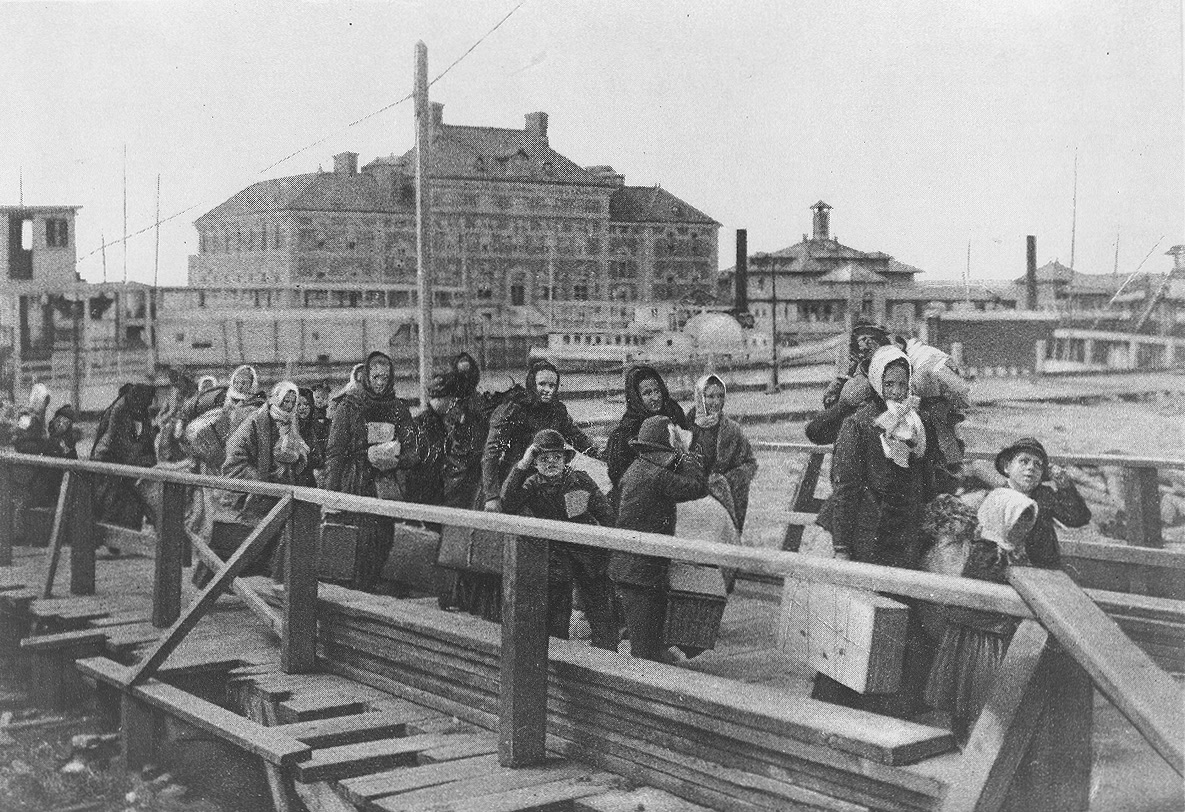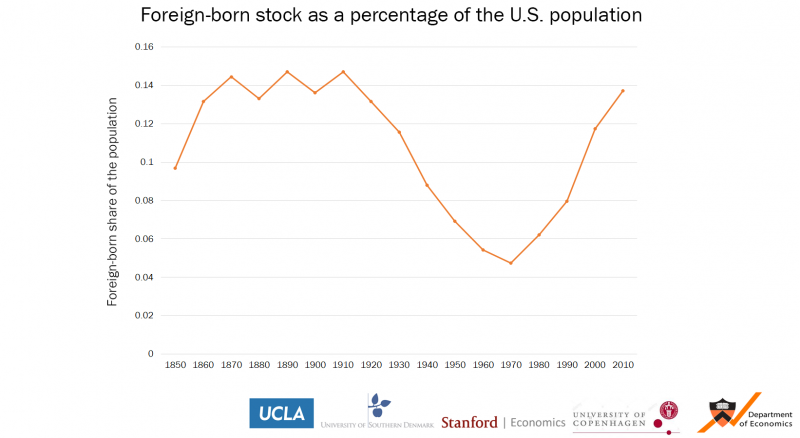December 2019
This paper is now published in the American Economic Journal: Applied Economics.
A common refrain in discussions of immigration policy is the concern that high rates of immigration result in fewer job opportunities and lower wages for U.S. workers. As economic historians, we seek to study the effects of past immigration restrictions in order to produce hard evidence that might inform policy moving forward. What happens to regional labor markets when immigration is cut? Do immigration quotas improve labor market prospects or raise wages for U.S.-born workers? These are important questions that demand rigorous evaluation.
In a new working paper (PDF) with Philipp Ager of the University of Southern Denmark, Elior Cohen of UCLA, and Casper W. Hansen of the University of Copenhagen, we measure exposure of U.S. regional labor markets to national immigration quotas set in the 1920s—quotas that ultimately cut immigration to the U.S. by more than 80 percent. We find that these strict immigration quotas did not result in higher wages for U.S.-born workers. Instead, wages fell for U.S. workers in labor markets that were most affected by the decline in immigrant numbers while ongoing industrial and labor market transitions were accelerated. In rural areas, the farming industry moved toward automation. In urban areas, labor markets moved toward higher-skilled manufacturing.
While some of these effects are what policymakers at the time intended, others—for example the decrease in wages—are not. The closing of the border to mass migration in the 1920s was one of the most fundamental changes to U.S. immigration policy in the past century. Our analysis of the effects of these changes provides an important cautionary tale of how immigration policies can produce unintended consequences for U.S. workers and labor markets.
Our research setting
Before 1920, immigration from Europe to the U.S. was almost entirely unrestricted. In the 1920s, Congress passed a series of immigration quotas. The quotas were applied on a country-by-country basis and therefore restricted immigration from Southern and Eastern Europe more than immigration from Northern and Western Europe. Ultimately, immigration to the U.S. fell from around 1 million people a year to 150,000 people a year.
Because immigrants from certain countries tend to settle in areas with established networks of others from their home country, some U.S. labor markets were more “exposed” to the 1920s immigration quotas than others. Labor markets that had larger clusters of Russians or Italians, for example, were more affected by the policy than areas with clusters of Irish and Germans. All of this gave us a valuable setting for understanding how immigration quotas have historically affected exposed regional economies.
Unintended consequences of the 1920s quotas—and different effects in rural and urban areas
Our paper is a case study that examines the regional labor market effects of one period of severe immigration restrictions. While the labor market and economic conditions of today are of course very different than those of 100 years ago, the research illustrates how policies to reduce immigration can have unintended consequences.
In the 1920s, policymakers reduced immigration with several cultural and economic goals in mind. One economic goal was to reduce the number of low-skilled workers in the U.S. economy, therefore allowing manufacturing to evolve in the direction of higher-skilled, higher productivity manufacturing activity. Another was to boost wages of U.S.-born workers—and in particular white U.S.-born workers. Jeremiah Jenks, an economist at Cornell and member of the bipartisan Dillingham Commission for the study of immigration in Congress, wrote in 1912 that “it is undoubtedly true that the availability of the large supply of recent immigrant labor has prevented an increase in wages which otherwise would have resulted during recent years from the increased demand for labor.”
The first goal of the commission was achieved. In urban areas exposed to the immigration quotas, many foreign-born workers were replaced by U.S.-born workers who were higher-skilled. The new arrivals filled only 50 percent of low-skilled blue-collar positions previously held by immigrants, contributing—as policymakers wanted—to a shift toward more skill-intensive manufacturing practices. However, policymakers did not anticipate that it would be Mexican migrants (who were unrestricted by the quota policy) and not U.S. workers that would ultimately move in to those vacant low-skilled positions in U.S. cities.
The post-quota job prospects were less optimistic for U.S.-born workers in rural areas. In rural areas, new quotas resulted in fewer workers, but those workers were not replaced with U.S.-born workers. Instead, land owners largely invested in capital and technology to replace them, forcing many U.S.-born workers to move out of rural areas.
An additional unintended consequence was the effect on wages, as we find that the immigration quotas established in the 1920s didn’t boost wages for workers anywhere. In both the urban and rural areas that lost the largest number of immigrant workers, occupation-based earnings of the U.S.-born actually declined after border closure by 0.5 percent for every 1 percentage point difference in quota exposure in urban areas and by 0.3 percent for every 1 percentage point difference in quota exposure in rural areas. Ironically, the new workers that moved in to U.S. cities post-quota created more competition than the immigrant workers policymakers had tried to expel, thereby pushing down wages for workers who’d been there all along.
Conclusion
Taken together, our findings suggest that policymakers debating immigration quotas or other restrictions—for example the debate around the 2017 RAISE Act—need to consider the possibility of unintended consequences. Though some argue that immigrants “take jobs” from U.S. workers, and therefore U.S. workers will benefit if immigration is restricted, our research suggests the economic effects of restricting immigration are not so straightforward. While lost immigrant workers can be replaced by new workers (for example through outsourcing), they can also be replaced by new capital (for example through automation), which in turn might also replace U.S.-born workers.

